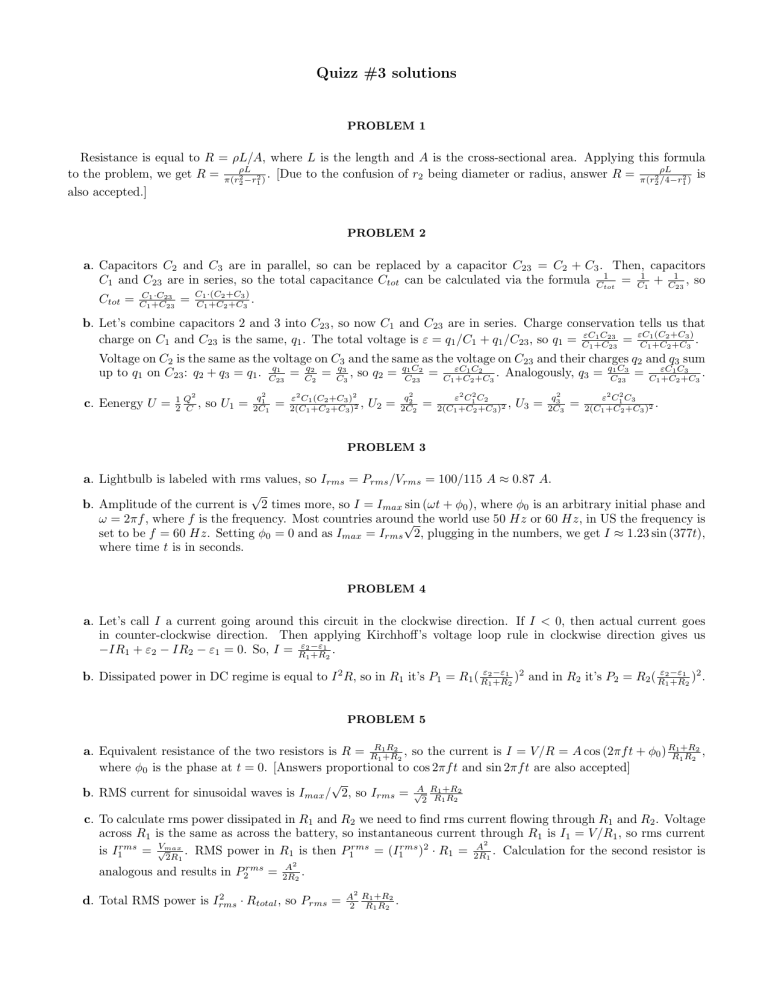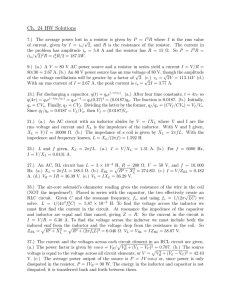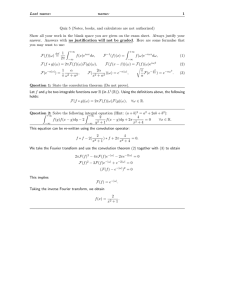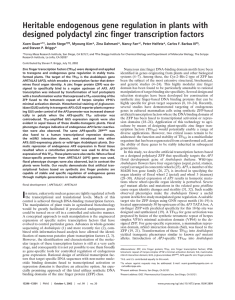Quizz #3 solutions
advertisement

Quizz #3 solutions PROBLEM 1 Resistance is equal to R = ρL/A, where L is the length and A is the cross-sectional area. Applying this formula ρL to the problem, we get R = π(rρL 2 2 . [Due to the confusion of r2 being diameter or radius, answer R = π(r 2 /4−r 2 ) is 2 −r1 ) 2 1 also accepted.] PROBLEM 2 a. Capacitors C2 and C3 are in parallel, so can be replaced by a capacitor C23 = C2 + C3 . Then, capacitors C1 and C23 are in series, so the total capacitance Ctot can be calculated via the formula C1tot = C11 + C123 , so Ctot = C1 ·C23 C1 +C23 = C1 ·(C2 +C3 ) C1 +C2 +C3 . b. Let’s combine capacitors 2 and 3 into C23 , so now C1 and C23 are in series. Charge conservation tells us that 1 (C2 +C3 ) 1 C23 charge on C1 and C23 is the same, q1 . The total voltage is ε = q1 /C1 + q1 /C23 , so q1 = CεC1 +C = εC C1 +C2 +C3 . 23 Voltage on C2 is the same as the voltage on C3 and the same as the voltage on C23 and their charges q2 and q3 sum q1 C3 εC1 C3 2 1 1 C2 = Cq22 = Cq33 , so q2 = qC1 C = C1εC up to q1 on C23 : q2 + q3 = q1 . Cq23 +C2 +C3 . Analogously, q3 = C23 = C1 +C2 +C3 . 23 c. Eenergy U = 2 1Q 2 C , so U1 = q12 2C1 = ε2 C1 (C2 +C3 )2 2(C1 +C2 +C3 )2 , U2 = q22 2C2 = ε2 C12 C2 2(C1 +C2 +C3 )2 , U3 = q32 2C3 = ε2 C12 C3 2(C1 +C2 +C3 )2 . PROBLEM 3 a. Lightbulb is labeled with rms values, so Irms = Prms /Vrms = 100/115 A ≈ 0.87 A. √ b. Amplitude of the current is 2 times more, so I = Imax sin (ωt + φ0 ), where φ0 is an arbitrary initial phase and ω = 2πf , where f is the frequency. Most countries around √ the world use 50 Hz or 60 Hz, in US the frequency is set to be f = 60 Hz. Setting φ0 = 0 and as Imax = Irms 2, plugging in the numbers, we get I ≈ 1.23 sin (377t), where time t is in seconds. PROBLEM 4 a. Let’s call I a current going around this circuit in the clockwise direction. If I < 0, then actual current goes in counter-clockwise direction. Then applying Kirchhoff’s voltage loop rule in clockwise direction gives us 1 −IR1 + ε2 − IR2 − ε1 = 0. So, I = Rε21 −ε +R2 . ε2 −ε1 2 2 1 b. Dissipated power in DC regime is equal to I 2 R, so in R1 it’s P1 = R1 ( Rε21 −ε +R2 ) and in R2 it’s P2 = R2 ( R1 +R2 ) . PROBLEM 5 R2 2 a. Equivalent resistance of the two resistors is R = RR11+R , so the current is I = V /R = A cos (2πf t + φ0 ) RR11+R R2 , 2 where φ0 is the phase at t = 0. [Answers proportional to cos 2πf t and sin 2πf t are also accepted] √ 2 b. RMS current for sinusoidal waves is Imax / 2, so Irms = √A2 RR11+R R2 c. To calculate rms power dissipated in R1 and R2 we need to find rms current flowing through R1 and R2 . Voltage across R1 is the same as across the battery, so instantaneous current through R1 is I1 = V /R1 , so rms current Vmax A2 is I1rms = √ . RMS power in R1 is then P1rms = (I1rms )2 · R1 = 2R . Calculation for the second resistor is 1 2R 1 analogous and results in P2rms = A2 2R2 . 2 d. Total RMS power is Irms · Rtotal , so Prms = A2 R1 +R2 2 R1 R2 . 2 2 2 2 A A 2 e. We want to check that total Prms = P1rms + P2rms . It’s true: A2 RR11+R R2 = 2R1 + 2R2 . [We could also check that 2 instantaneous power produced by the source dissipates in resistors. Ptot = IV = A2 cos2 (2πf t + φ0 ) RR11+R R2 . 2 A P1 = V12 /R1 = R cos2 (2πf t + φ0 ) and by analogy P2 = V22 /R2 = 1 A cos (2πf t + φ0 ). We can see that indeed Ptot = P1 + P2 .] A2 R2 cos2 (2πf t + φ0 ). Here V1 = V2 = V =






